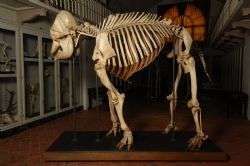Research discovers new 'type specimen' for the Asian elephant

Findings from a scientific historian at the University of Lincoln have helped experts at the Natural History Museum to designate an animal painted by Rembrandt as the new 'type specimen' for the Asian elephant species.
Research by Dr Anna-Marie Roos, Senior Lecturer in the University of Lincoln's School of Humanities, was coupled with scientific discoveries from the Natural History Museums in London, Denmark, Sweden and Florence and the Universities of Oxford and Illinois Urbana-Champaign. Together they place an Asian elephant, which was drawn in life by Rembrandt in 1637 and is now on display as a skeleton in Florence, at the centre of a centuries-old science story that began with Carl Linnaeus.
The Swedish naturalist Linnaeus, who laid the foundations for the scientific field of taxonomy (encompassing the description, identification and classification of organisms), used a description of the skeleton together with a pickled elephant foetus from the collection of Albertus Seba to create the first scientific description of Elephus Maximus, the Asian elephant species.
Seba's elephant was therefore, until now, recognised as the 'type specimen' – the oldest known scientific specimen to which a specific location can be attributed, and the earliest reference point for the species. However, the team's research has now proved that this classification is wrong, as Seba's elephant was is in fact Loxodonta, an African elephant.
Tom Gilbert, senior author of the study from the Natural History Museum of Denmark, said: "Linnaeus did not distinguish between Asian and African elephants when he wrote his seminal work in the eighteenth century. We combined genetics and proteomics to show that Seba's elephant, which we had thought was the best surviving type specimen for the Asian elephant, is actually a completely different species, namely the African elephant. This then left us to question what and where is the type specimen for the Asian elephant?"
Through extensive archival research, Dr Roos was able to prove that the skeleton described by British naturalist John Ray and referred to by Linnaeus is the same organism now on public display at the Natural History Museum in Florence. Dr Roos discovered and translated a number of letters written by Ray while visiting Florence in 1664, to prove that this skeleton should be recognised as the new 'type specimen'.
She said: "John Ray is renowned as the "father of natural history", and while in Florence during the 1660s, he encountered a selection of curiosities owned by the Duke of Florence. We now know that the elephant he saw and described there is the same specimen housed in the museum today, because he alludes to certain anatomical peculiarities consistent with the Florence skeleton, such as a missing sternum. Bones and teeth from the Florence skeleton were then used to confirm it as an Asian elephant, so that we can confidently propose this elephant as the new 'type specimen' for the species.
"Scientists are not always confident of the accuracy of some 'type specimen' identifications, particularly for species described a long time ago. This is particularly so for rare or obscure species, while it is much more infrequent for such an iconic and world-famous animal as the elephant. This discovery therefore highlights why it is so vitally important for historical records and manuscripts to be considered alongside scientific evidence."
Enrico Cappellini, lead author of the study from the Natural History Museum of Denmark, said: "It is remarkable to think that it is through combining observations made more than 200 years ago by Linnaeus, Seba and John Ray, with state-of-the-art experimental research available using ancient proteomics and DNA, that we have been able to provide the Asian elephant with its correct type specimen. That you can still see it as a life drawing by Rembrandt demonstrates how science and art remain inseparable."
The findings were published in the Zoological Journal of the Linnean Society on 4th November 2013.
Provided by University of Lincoln


















